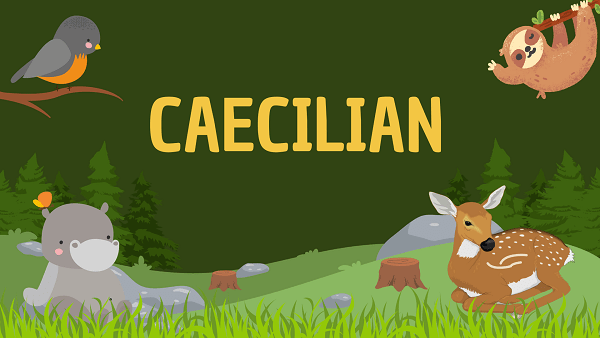Caecilian | Facts, Diet, Habitat & Pictures
Home » Animals » Caecilian | Facts, Diet, Habitat & Pictures
Caecilian Overview
Appearance
Caecilian is a limbless amphibians that resemble elongated, worm-like creatures. Their bodies are covered in smooth, moist, and ring-like segments, giving them a segmented appearance. Their skin is typically dark in color, ranging from gray to brown or even purple.
Caecilians have small, sensory tentacles on their heads, which help them detect prey and navigate their underground habitats. These amphibians lack external eyes, and their mouth is equipped with rows of tiny, pointed teeth for capturing and consuming small invertebrates.
Origins And Evolution
Caecilians have a long evolutionary history dating back to the Jurassic period, approximately 200 million years ago. They belong to the order Gymnophiona, which is one of the three orders of amphibians.
Their ancestors are believed to have been aquatic creatures, and over time, they adapted to a burrowing lifestyle. Their limblessness and elongated body shape evolved as adaptations for burrowing through soil and leaf litter.
Caecilians are part of the broader group of amphibians, which includes frogs and salamanders. Despite their ancient lineage, they are relatively understudied compared to other amphibian groups.
Caecilians have unique reproductive strategies, such as internal fertilization and live birth in some species. Their evolutionary history and adaptations make them a fascinating and distinct group within the amphibian class.
Behavior and Lifestyle
Caecilians are primarily subterranean creatures, spending much of their lives underground. They are nocturnal and exhibit secretive behavior, rarely seen above ground. Their diet consists mainly of soil-dwelling invertebrates, which they capture using their specialized sensory tentacles and rows of tiny teeth.
Caecilians are known to engage in burrowing behavior, creating tunnels in the soil or leaf litter, and they can even secrete a slimy substance to aid in burrowing. While they are predominantly solitary, they may come together during the breeding season, exhibiting unique courtship and reproductive behaviors.
Scientific Classification
- Kingdom: Animalia (Animals)
- Phylum: Chordata (Chordates)
- Subphylum: Vertebrata (Vertebrates)
- Class: Amphibia (Amphibians)
- Order: Gymnophiona (Caecilians)
Locations
- South America
- Central America
- Africa
- Southeast Asia
- India
- Sri Lanka
- Madagascar
- Some Pacific islands
Fast Facts
- Name: Caecilian
- Scientific Name: Various species
- Habitat: Tropical Soils
- Diet: Invertebrates, Small Vertebrates
- Physical Features: Legless, Smooth Skin
- Nocturnal: Mostly Nocturnal
- Solitary: Often Solitary
- Unique Order: Gymnophiona
- Lifespan: 5-10 Years
- Conservation Status: Varied
- Fun Facts: Limbless Amphibian, Underground Dweller
Physical Characteristics
- Color: Varied Tones
- Skin Type: Smooth, Moist
- Top Speed: Slow Movement
- Lifespan: 5-10 Years
- Weight: Lightweight Body
- Length: 4-36 Inches
- Age of Sexual Maturity: 2-3 Years
- Age of Weaning: Not Applicable
Caecilian FAQs
What is a caecilian?
A caecilian is a limbless amphibian that resembles a long, segmented worm and belongs to the order Gymnophiona.
Are caecilians related to snakes?
No, despite their superficial resemblance to snakes, caecilians are amphibians, while snakes are reptiles.
Where are caecilians found?
Caecilians are primarily found in tropical regions, including parts of South America, Africa, Southeast Asia, and the Indian subcontinent.
What do caecilians eat?
Caecilians are carnivorous and primarily feed on insect larvae, worms, and small invertebrates.
Do caecilians have eyes?
Some species have reduced or vestigial eyes, while others are completely eyeless, relying on other sensory organs for navigation and prey detection.
How do caecilians reproduce?
Caecilians exhibit various reproductive strategies, including internal fertilization and either laying eggs or giving birth to live young, depending on the species.
Are caecilians nocturnal?
Yes, caecilians are primarily nocturnal, meaning they are most active during the night.


